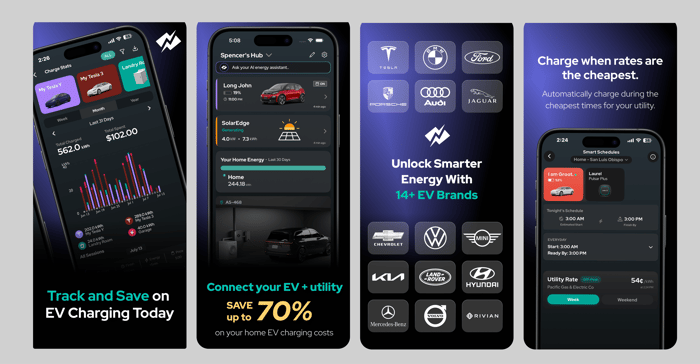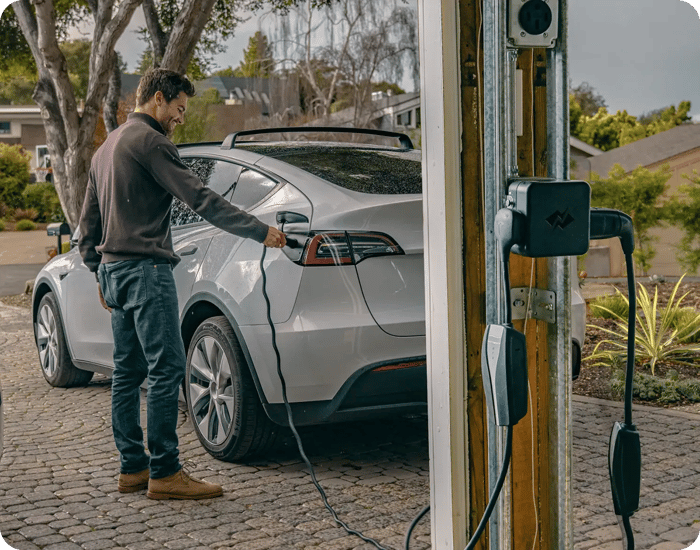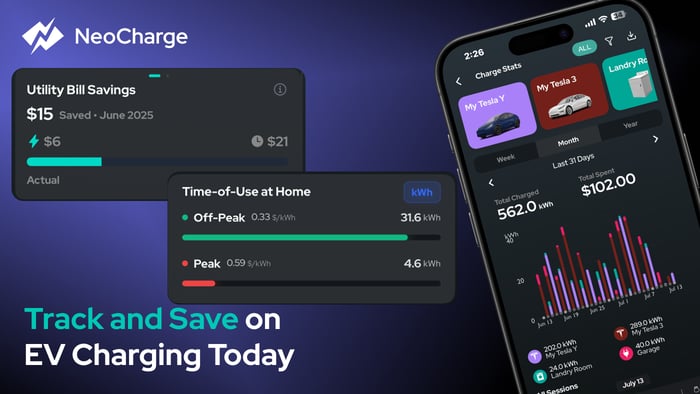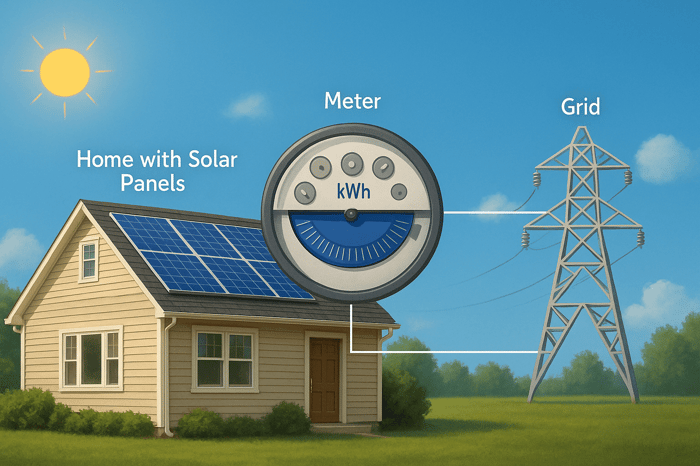Table of Contents
- The Two EV Home Charging Dilemma Most People Face
- How the NeoCharge Smart Splitter Actually Works
- Setting Up Takes Less Time Than Making Coffee
- The Hidden Benefit Nobody Talks About
- Safety First, Always
- Real Household Examples
- Common Questions Answered
- Why This Beats Expensive Electrical Work
- Getting Started Today
- FAQs
By Holden Kooiker, COO — NeoCharge
Picture this: You and your partner both drive electric, but your house has exactly one 240V outlet in the garage. Sound familiar? You're not alone. Most homes weren't built for the multi-EV future we're living in, and getting an electrician to add another circuit can cost thousands of dollars.
Here's the good news: you don't need to choose between cars or drain your savings account, get an EV charging splitter. The NeoCharge Smart Splitter turns your single outlet into an intelligent charging hub that keeps both vehicles happy, charged, and ready to go.
The Two EV Home Charging Dilemma Most People Face
Sarah from Portland messaged us last month: "My husband and I both have Teslas, but we were taking turns charging like it's 1995. One night I forgot to switch the cable, and he was stuck with 12% battery for his morning commute. We almost bought a gas car as backup!"
Sarah's story isn't unique. Traditional solutions like manual switching are inconvenient, forgettable, unsafe, and frankly ridiculous in 2025. Adding a second 240V circuit typically costs $1,500 to $4,800, especially if your panel needs upgrading. That's a lot of money just to avoid playing musical car cables.
How the NeoCharge Smart Splitter Actually Works
Think of the Smart Splitter as a really smart traffic controller or smart power strip for your 240V outlet. When you plug in both cars, it senses which one needs power first and delivers it automatically. No more manual switching, no more forgotten cables, no more morning arguments about who gets to charge.
The magic happens through intelligent auto-switching. If your Model Y is charging and you plug in the Ford Lightning, the splitter lets the Tesla finish first, then seamlessly switches to the Ford. It's like having a personal charging assistant who never sleeps.
For Tesla owners, there's an even cooler option: 50/50 power sharing. When you set both cars at 20 Amps, both cars can charge simultaneously at half speed, which is perfect for overnight charging when time isn't critical.
Setting Up Takes Less Time Than Making Coffee
Installation is surprisingly simple. The Smart Splitter plugs directly into your existing NEMA 14-50, 14-30, or 10-30 outlet. No rewiring, no electrician visits, no permit applications. We're talking about a five-minute setup that saves you thousands.
Once it's connected, open the NeoCharge app and pair your vehicles. Give them fun names like "Daily Driver" and "Weekend Warrior" or keep it simple with "Car 1" and "Car 2." The choice is yours.
Then comes the really smart part: setting up your finish-by schedules. Tell the app when each car needs to be ready, and it handles the rest. Want the commuter car done by 7 AM and the weekend car ready by 9 AM? No problem. With the NeoCharge app you can automatically charges during the cheapest off-peak hours (such as in PG&E territory EV rates) while making sure both EVs are charged up.
The Hidden Benefit Nobody Talks About
Beyond solving the outlet shortage, Smart Splitter integration gives you unprecedented visibility into your home's energy usage. The NeoCharge app shows exactly what each car costs per session, which vehicle is more efficient, and how much you're saving by charging during off-peak hours.
Mike from San Diego told us, "I never realized our Model S was costing $23 more per month than our Model 3 until I saw the per-car breakdowns. Now we use the Model 3 for longer trips and save serious money."
This level of detail is impossible with separate charging setups, other circuit splitters on the market, and makes household energy budgeting incredibly easy.
Safety First, Always
You might wonder if sharing a single outlet between two high-powered devices is safe. The short answer is absolutely, when done correctly. The Smart Splitter is UL listed and includes internal breakers and intelligent load management to prevent any circuit overloads. It adheres to important National Electric Codes to ensure you don't pull more then 80% of your breaker rating.
Real Household Examples
Jennifer and Tom in Seattle share a 14-50 outlet between their BMW iX and Ford Mustang Mach-E. They set the BMW to finish by 6:30 AM for Jennifer's commute and the Ford to complete by 8 AM for Tom's later schedule. Both cars charge during Seattle's super off-peak rates from midnight to 6 AM, saving them $89 per month compared to charging during evening hours.
Lisa in San Diego uses her NEMA 14-30 dryer outlet for both her Tesla Model Y with SDG&E as her utility. The Smart Splitter prioritizes the dryer when clothes need to be dried and the Tesla will charge when not active. This means safe charging and fast charging when needed.
Common Questions Answered
People often ask if both cars can charge simultaneously. The answer depends on your setup. In 50/50 Tesla mode, yes, both cars share power within your circuit's limits. For all other configurations, the splitter intelligently switches between devices to prevent overloads.
Scheduling absolutely works with two cars. In fact, it works better than single-car setups because the app coordinates the handoff automatically. Set individual finish-by times for each vehicle, and wake up to both cars ready to go.
Override capability remains instant. Need to top up one car immediately? Tap Start/Stop in the app, and charging begins regardless of schedules or queue position.
Why This Beats Expensive Electrical Work
A Smart Splitter costs just a few hundred dollars and installs in minutes. Compare that to $2,500-$4,800 for new circuit or panel upgrade, plus weeks of scheduling electricians and pulling permits. The math is pretty straightforward.
Plus, you get ongoing benefits that new circuits can't provide: intelligent scheduling, per-car cost tracking, and the flexibility to easily relocate your charging setup if needed.
| Solution | Cost | Installation Time | Permits Required |
|---|---|---|---|
| Smart Splitter | $320-$499 | 5 minutes | No |
| Second Circuit | $750-$3,800 | 1-2 weeks | Yes |
| Panel Upgrade | $2,250-$4,600 | 2-3 weeks | Yes |
Getting Started Today
Download the NeoCharge App and connect your first EV to start tracking costs immediately. You don't need a Smart Splitter to begin saving with smart scheduling and precise cost tracking. Plus if you need a Level 2 Wallbox Pulsar Plus EV Charger or any other Home EV Charging accessories we got you covered.
When you're ready to solve the two-car, one- 240V outlet challenge, the Smart Splitter integrates seamlessly with your existing app setup. Most customers see the hardware pay right away compared to panel upgrades plus more additional savings through optimized off-peak charging.
Ready to get safe, fast, and easier charging at home for your Two EVs or your dryer and EV? Check out the NeoCharge Smart Splitter.
FAQs
Can you safely charge two electric cars with one 240V outlet without hiring an electrician?
Yes, absolutely. The NeoCharge Smart Splitter is UL listed and specifically designed to safely share a single 240V outlet between two electric vehicles without requiring any electrical work. It plugs directly into your existing NEMA 14-50, 14-30, or 10-30 outlet and includes internal breakers plus intelligent load management to prevent circuit overloads.
The device adheres to National Electric Codes, ensuring you never pull more than 80% of your breaker's rating. Installation takes just 5 minutes – no rewiring, no electrician visits, no permits required. Unlike manual switching solutions that can be unsafe and inconvenient, the Smart Splitter automatically manages power distribution between vehicles, eliminating human error and ensuring safe operation 24/7.
How much money can you save using an EV outlet splitter vs installing a second charging circuit?
You can save $2,200 to $4,500 upfront, plus ongoing monthly savings. A NeoCharge Smart Splitter costs just a few hundred dollars and installs in minutes, while adding a second 240V circuit typically costs $1,500 to $4,800 (especially if your electrical panel needs upgrading).
Beyond the massive upfront savings, you get ongoing benefits that separate circuits can't provide: intelligent scheduling for off-peak charging, per-car cost tracking, and automatic coordination between vehicles. The hardware typically pays for itself immediately compared to panel upgrades, plus delivers additional monthly savings through optimized charging schedules.
What's the easiest way to automatically charge two electric cars overnight without manual switching?
The NeoCharge Smart Splitter with intelligent scheduling is the hands-down easiest solution. Plug in both your vehicles on both side of the 240V Smart Splitter and it auto switches between your vehicles for you. Plus its the most affordable solution to this problem you can find.
The system automatically handles everything: it charges during the cheapest off-peak hours, coordinates the handoff between vehicles, and ensures both cars are ready when you need them. No more manual cable switching, no more forgotten charges, no more morning arguments about who gets to charge. Real customers like Sarah from Portland went from "taking turns charging like it's 1995" to completely automated, worry-free charging for both their Teslas.
Is a NEMA 14-50 outlet splitter for EVs actually UL listed and code compliant?
Yes, the NeoCharge Smart Splitter is fully UL listed and National Electric Code compliant. This isn't some generic power strip – it's specifically engineered for high-power EV charging applications with built-in safety features including internal breakers and intelligent load management.
The device automatically ensures you never exceed 80% of your breaker's rating (per NEC requirements) and includes multiple safety mechanisms to prevent overloads, overheating, and other electrical hazards. Unlike manual switching solutions or non-certified splitters, the Smart Splitter meets all applicable electrical codes and safety standards. When dealing with 240V, 40-50 amp circuits, UL certification isn't optional – it's essential for both safety and insurance purposes.








